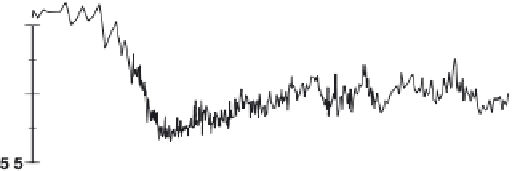Geoscience Reference
In-Depth Information
speeds (higher mean grain size values) during the cold peri-
ods [Voelker et al., 2006]. Temperatures in the upper NADW
(Figure 8f) [Skinner and Elder
[2007] attribute to the potential admixing of MOW, which
are similar to the last deglaciations, could have reached as
deep down as 2200 m on the Sines margin [Schönfeld and
Zahn, 2000]. Admixing of deeper
eld, 2007] generally also
follow the Greenland-type pattern with warmer DWT during
the interstadials and colder ones during the stadials as to be
expected by changes in NADW or AABW predominantly
bathing the site, respectively. The DWT record of site MD01-
2444, however, also shows short-term warming events dur-
ing Heinrich stadials 4 and 5 that Skinner and Elder
flowing MOW into depths
of 2465 m could also explain some of the signals seen in the
benthic stable isotope records of core MD95-2040 (Figures 5e,
5f ) farther to the north. The shift from a Greenland- to an
Antarctic-type climate signal occurred somewhere between
2500 and 3100 m water depth where the benthic
18
O signal
eld
δ
Figure 8













































































































































Search WWH ::

Custom Search